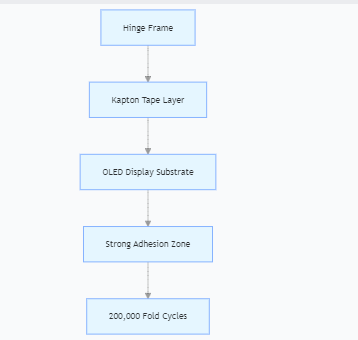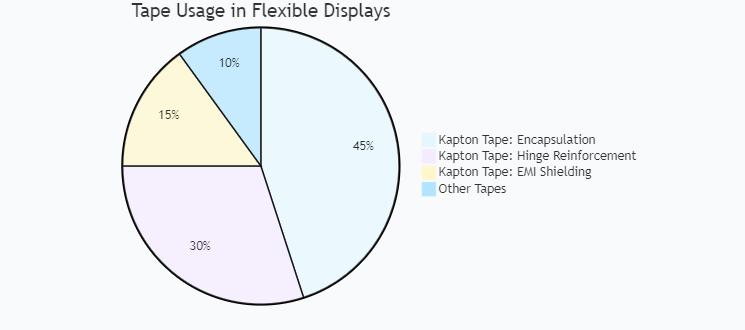



Where Is Gold Finger Electronics Polyimide Tape Kapton Used in Flexible Display Technologies? |https://www.lvmeikapton.com/
1. Introduction: The Rise of Flexible Displays
2. Material Requirements for Flexible Displays
2.1 Mechanical Durability
Fold Cycle Endurance: Must withstand >100,000 bends without delamination or material fatigue.
Tensile Strength: High resistance to stretching during display flexing.
2.2 Thermal Stability
Operating Temperatures: -40°C to 85°C for consumer devices, with peak tolerance up to 200°C during manufacturing processes.
2.3 Electrical Performance
Dielectric Insulation: Protection against short circuits in OLED drive electronics.
EMI Shielding: Reduction of electromagnetic interference affecting display quality.
3. Kapton Tape: A Solution for Flexible Display Challenges
3.1 Fold Cycle Superiority
3.2 Material Properties
Tensile Strength: 200 MPa, preventing stretching-induced pixel distortion.
Thermal Expansion Coefficient: 15 ppm/°C, minimizing thermal stress on OLED layers.
4. Key Applications in Flexible Display Technologies
4.1 OLED Encapsulation
Function: Protects organic layers from moisture (≤0.001 g/m²/day water vapor transmission) and oxygen (≤0.0001 cc/m²/day O₂ permeation).
Kapton Tape Role:
Forms a hermetic seal around OLED panels, outperforming Brown circuit board tape’s 10x higher permeation rate.
Maintains adhesion at 85% RH for 1,000 hours, ensuring long-term display reliability.
Implementation: Kapton Tape with ALD (Atomic Layer Deposition) coating encapsulates the OLED display.
Results:
Display lifespan extended from 3 to 5 years under daily use.
Moisture-induced pixel failures reduced by 92%.
4.2 Hinge Reinforcement
Challenge: Hinges endure extreme mechanical stress during folding.
Kapton Tape Solution:
Strong adhesion (4.5 N/cm peel strength) secures hinge components, preventing loosening.
Flex fatigue resistance enables seamless folding without adhesive breakdown.

4.3 EMI Shielding in Display Electronics
Requirement: Minimize interference between OLED drivers and touch sensors.
Kapton Tape Advantage:
Conductive variants (copper-coated) provide 99.9% EMI shielding at 60 GHz.
Ultra-thin profiles (0.025 mm) fit within tight display bezels.
5. Comparative Analysis: Kapton Tape vs. Alternatives
5.1 Adhesive PET Material High Temperature Tape
Limitations:
Low fold cycle endurance leads to early delamination.
Higher thermal expansion (50 ppm/°C) causes layer misalignment in hot environments.
5.2 Brown Circuit Board High Temperature Tape
Drawbacks:
Poor moisture barrier results in OLED degradation.
Lower peel strength (2.8 N/cm) fails to secure hinge components long-term.
6. Manufacturing Integration and Quality Control
6.1 Precision Application Techniques
Laser Cutting: ±0.01 mm precision for custom-shaped tapes around curved displays.
Roll-to-Roll Processing: High-speed application during OLED panel assembly.
6.2 Testing Standards
ISO 11925-2: Flame retardancy testing (Kapton Tape achieves UL 94 V-0 rating).
ASTM D3330: Peel adhesion measurement under various humidity conditions.
7. Future Trends and Innovations
7.1 Self-Healing Polyimide Tapes
Development: Microencapsulated adhesives that repair minor cracks during folding.
Impact: Projected to increase fold cycles to 500,000+ by 2026.
7.2 Transparent Conductive Kapton Variants
Advancement: Incorporating graphene oxide for touchscreen functionality within the tape layer.
Benefit: Reduces display stack thickness by 30%.
8. Cost-Benefit Analysis
8.1 Production Economics

8.2 Consumer Impact
Device Lifespan: 2-year extension in flexible phone warranties.
Repair Costs: 40% reduction in hinge-related service claims.
9. Conclusion







